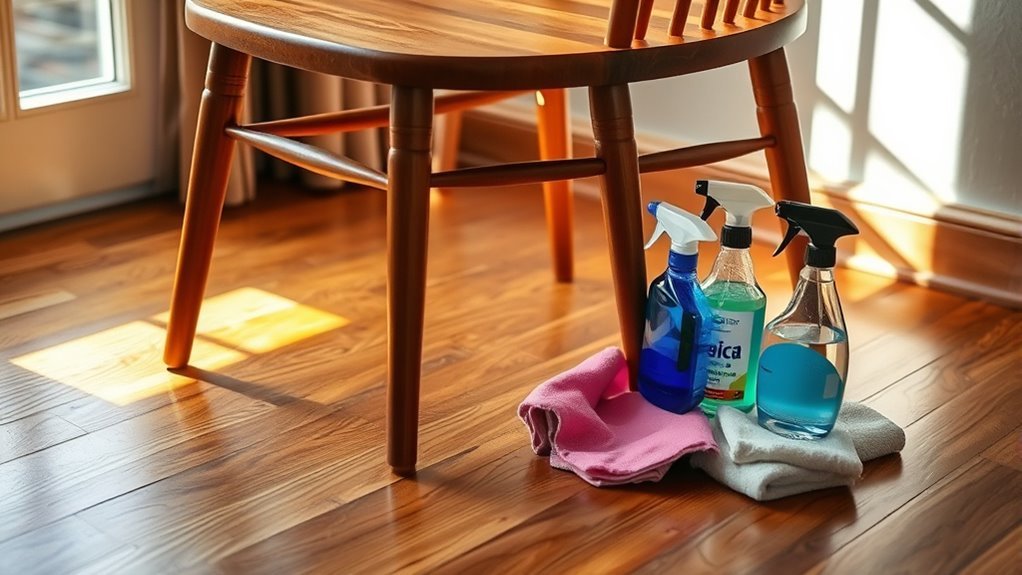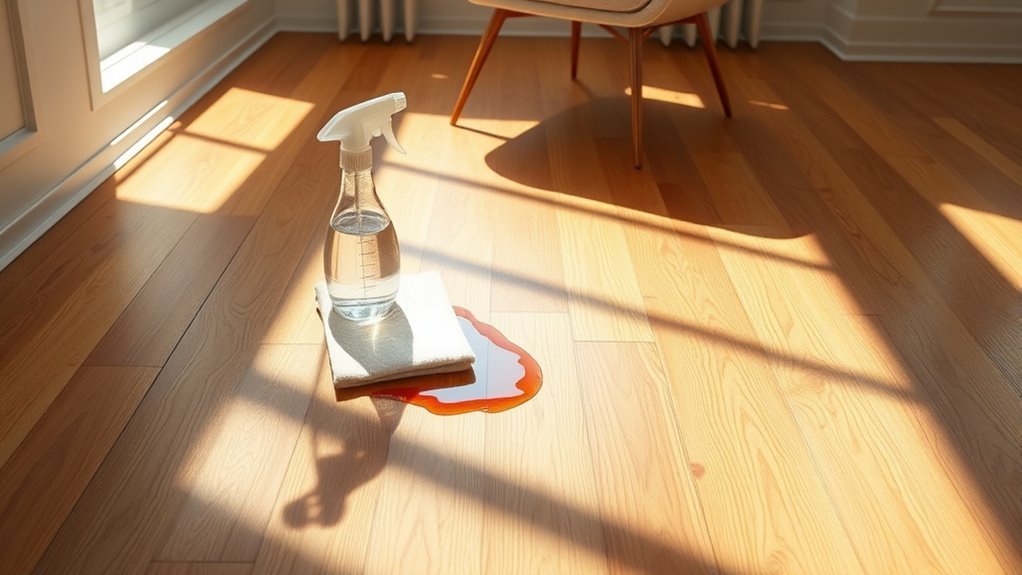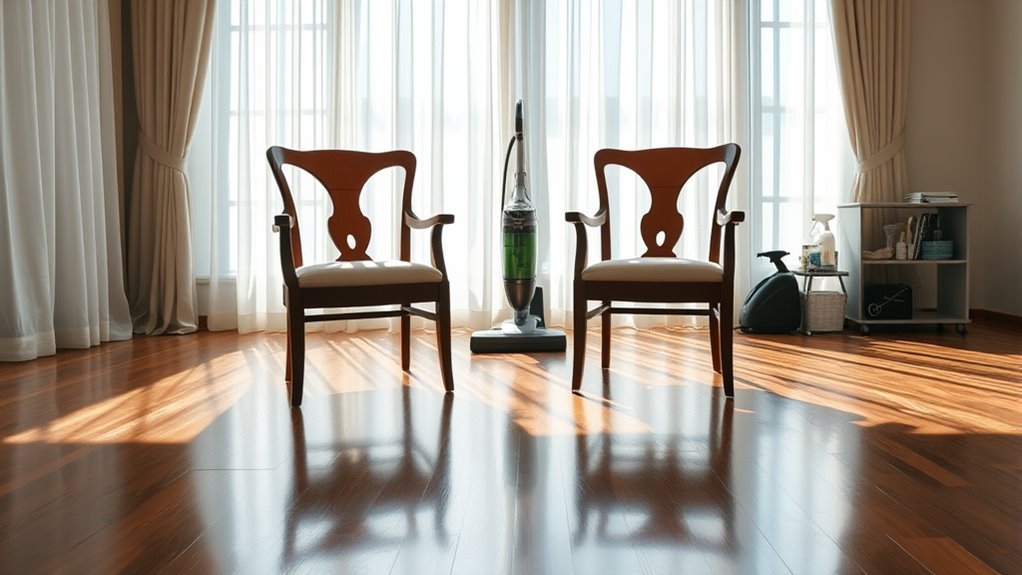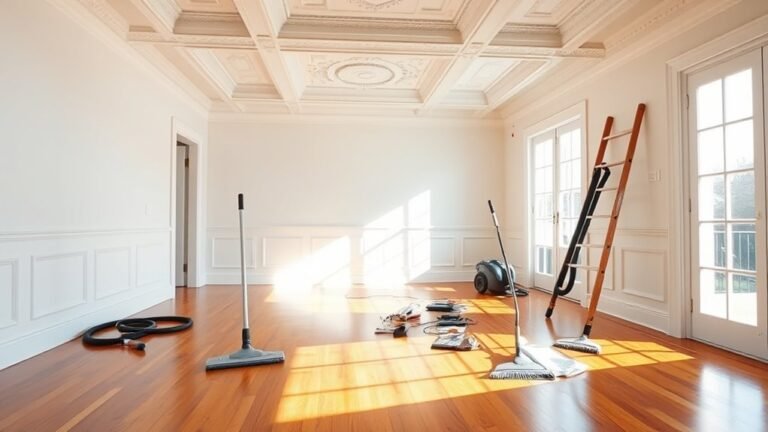Deep Cleaning Guide for Chair Flooring
To deep clean your chair flooring, first identify its type—hardwood, laminate, tile, or vinyl—then choose suitable tools like microfiber cloths and gentle, floor-appropriate cleaners. Clear the area, remove dust with a vacuum or soft brush, and apply cleaner sparingly to avoid damage. Blot spills promptly and protect floors with pads under chair legs. Consistent cleaning and preventative care will keep your floors pristine and durable. With a few more tips, you can master thorough maintenance techniques.
Identifying Your Chair Flooring Material

How do you determine the type of flooring your chair is on? Start by examining the surface closely, focusing on material characteristics such as texture, color, and hardness. Common types of flooring include hardwood, laminate, vinyl, tile, and carpet. Hardwood features natural grain patterns and feels solid underfoot, while laminate mimics wood but has a smoother, synthetic finish. Vinyl offers a slightly softer, water-resistant surface, and tile is cool and hard with visible grout lines. Carpet varies in fiber density and softness. Identifying these differences helps you understand how your chair interacts with the floor. Knowing the exact type of flooring allows you to tailor your cleaning approach effectively, preserving the material’s integrity while maintaining your freedom to move and clean without restrictions. Laminate flooring, for example, requires special care to avoid excess moisture and scratching, which can affect its durability and maintenance.
Essential Tools and Cleaning Products
To clean your chair flooring effectively, you’ll need a selection of essential tools like microfiber cloths, soft-bristle brushes, and a vacuum with appropriate attachments. Choosing the right cleaning solutions is equally important—opt for products specifically designed for your flooring material to avoid damage. With the correct tools and cleaners, you’ll guarantee a thorough and safe deep cleaning process. It is also crucial to avoid excess water during cleaning to prevent damage to both fabric and wood surfaces.
Must-Have Cleaning Tools
Five essential tools will make deep cleaning your chair flooring more efficient and effective. First, a high-quality vacuum with attachments helps you remove dust and debris from tight corners and under chair legs. Next, microfiber cloths efficiently trap dirt without damaging surfaces, perfect for spot cleaning. A sturdy scrub brush with gentle bristles tackles stubborn grime without scratching. You’ll also want a mop compatible with eco friendly supplies, ensuring you clean thoroughly while respecting your space and the environment. Finally, select versatile cleaning gadgets like handheld steam cleaners—they reach hidden areas and sanitize without harsh chemicals. Using these tools systematically gives you control, letting you maintain pristine chair flooring with minimal effort and maximum freedom.
Recommended Cleaning Solutions
Having the right tools at hand is only part of the process; selecting appropriate cleaning solutions tailored to your chair flooring can greatly impact the results. Start by choosing eco friendly solutions that protect both your flooring and indoor air quality, ensuring a safe environment. For stubborn marks, opt for specialized stain removers designed for your flooring material—whether hardwood, laminate, or carpet. Always test these products in an inconspicuous area to prevent discoloration or damage. Avoid harsh chemicals that can degrade finishes or cause residue buildup. By using targeted, effective cleaning agents, you maintain the integrity of your flooring while freeing yourself from frequent, intensive cleanings. This methodical approach gives you lasting cleanliness and the freedom to enjoy your space without worry.
Step-by-Step Deep Cleaning Process

Before you begin, clear the area around your chair flooring to guarantee easy access and prevent damage. Follow specific cleaning techniques tailored to your flooring type for effective stain and dirt removal. Finally, focus on thorough drying and regular maintenance to preserve cleanliness and extend the flooring’s lifespan. Establishing a regular cleaning routine helps maintain the floor’s appearance and hygiene over time.
Preparing the Area
Although preparing the area may seem straightforward, it’s essential to follow a systematic approach to secure an effective deep cleaning of your chair flooring. Start by clearing clutter to ensure unobstructed access. Next, protect surfaces surrounding your workspace to prevent damage or stains during cleaning. This preparation sets the foundation for a thorough process.
| Step | Action | Purpose |
|---|---|---|
| 1 | Clear clutter | Ensure space to work freely |
| 2 | Move chairs | Access all floor areas |
| 3 | Cover nearby surfaces | Protect from cleaning agents |
| 4 | Check cleaning tools | Ready equipment for use |
| 5 | Ventilate the area | Improve drying and air flow |
Following these steps secures your chair flooring is primed for deep cleaning without obstacles or damage.
Cleaning Techniques
Start by selecting the appropriate cleaning method based on your chair flooring material. For hardwood, use a damp mop with a mild, eco friendly solution to avoid damage. Vinyl and laminate floors benefit from a gentle scrub with a soft brush and a natural cleaner. Carpets require vacuuming followed by spot treatment with biodegradable detergents. Maintain an ideal cleaning frequency—weekly for high-traffic areas and monthly for less used spots—to preserve floor integrity. Begin by removing loose debris, then apply your chosen cleaner evenly. Use controlled, methodical strokes to lift dirt without over-saturating the surface. Always test eco friendly solutions in a small area first to verify compatibility. By following these precise steps, you’ll extend your flooring’s lifespan while enjoying a cleaner, healthier environment.
Drying and Maintenance
Once you’ve thoroughly cleaned your chair flooring, ensuring it dries properly is essential to prevent damage and maintain its appearance. Start with effective drying techniques: open windows and doors to promote air circulation, or use fans set on low to avoid warping. Avoid direct sunlight, which can fade or crack surfaces. For faster drying, consider a dehumidifier in humid environments. Establish regular maintenance routines to extend your flooring’s life. Sweep or vacuum weekly to remove debris, and promptly clean spills to prevent stains. Periodically check for scratches or wear, applying appropriate finishes or sealants as needed. By following these precise drying and maintenance steps, you’ll preserve your chair flooring’s integrity and enjoy the freedom of a clean, durable space.
Removing Stains and Spills Effectively

When you notice stains or spills on your chair flooring, acting quickly is essential to prevent permanent damage. Start by blotting the spill gently with a clean cloth to absorb excess liquid—never rub, as this can spread the stain. For effective stain removal, use a mild detergent mixed with water or a specialized cleaner suitable for your floor type. Apply the solution sparingly, then blot again to lift the stain. Avoid saturating the area, which can cause warping or discoloration. For stubborn stains, repeat the spill treatment carefully, ensuring you don’t damage the flooring surface. Always test cleaners on a small, inconspicuous area first. By addressing stains and spills promptly and methodically, you maintain your flooring’s integrity and enjoy a clean, fresh space with freedom from worry. Additionally, incorporating preventative care measures can extend the life of your chair flooring and keep it looking its best.
Preventative Measures to Maintain Clean Floors
Although regular deep cleaning is essential, implementing preventative measures can greatly reduce dirt buildup and damage on your chair flooring. Start by using floor protection accessories like chair mats or glides to minimize scratches and wear from constant movement. Opt for preventative cleaning techniques such as removing shoes before entering the room and using doormats to trap dirt at entry points. Regularly vacuum or sweep to prevent abrasive particles from embedding into the floor surface. Additionally, consider applying a suitable floor sealant or finish to create a protective barrier against spills and stains. By adopting these strategies, you’ll maintain the integrity and appearance of your flooring, granting you the freedom to enjoy your space without the constant worry of damage or extensive cleaning needs. Using microfiber cloths for dusting and polishing nearby surfaces can also help reduce dust accumulation on floors.
Tips for Regular Upkeep and Long-Term Care
To keep your chair flooring in ideal condition, you’ll need a consistent routine that balances cleaning and maintenance tasks. Begin by scheduling routine inspections to identify wear, scratches, or dirt buildup early. This proactive approach prevents minor issues from escalating. Use appropriate cleaning agents suited for your floor type, avoiding harsh chemicals that degrade protective finishes. Reapply these finishes periodically to maintain a resilient barrier against damage and stains. Additionally, consider using chair mats or felt pads to minimize direct contact and abrasion. Regularly vacuum or sweep to remove grit that can scratch surfaces. By following these methodical steps, you preserve your flooring’s integrity, ensuring it remains a reliable foundation for your space. This disciplined upkeep grants you the freedom to enjoy your environment without unexpected floor repairs. Incorporating vacuum cleaners with upholstery attachments into your cleaning routine can effectively remove hidden debris that contributes to wear.
Frequently Asked Questions
Can Chair Mats Damage My Flooring Over Time?
When it comes to chair mats, it’s not always a bed of roses. Your flooring protection depends heavily on the chair mat materials you choose. Some plastics can yellow or stick, damaging your floor over time, especially on hardwood or carpet. To keep things smooth, pick a mat with a non-slip backing and made from quality PVC or polycarbonate. That way, you’ll enjoy freedom of movement without sacrificing your floor’s health.
How Often Should Professional Floor Cleaning Be Scheduled?
You should consider cleaning frequency based on your flooring type and usage. Professional recommendations usually suggest scheduling deep cleaning every 6 to 12 months to maintain peak condition. If your space experiences heavy foot traffic or spills often, more frequent cleanings might be necessary. Sticking to this schedule helps preserve your floor’s appearance and durability, giving you the freedom to enjoy your space without worrying about long-term damage.
Are Eco-Friendly Cleaning Products Effective for Deep Cleaning?
Think of eco-friendly cleaning products as the gentle rain nourishing your floors—natural yet powerful. Their eco friendly effectiveness lies in harnessing nature’s own agents, ensuring deep cleaning without harsh chemicals. When you choose natural cleaning, you’re embracing a method that respects your space and the planet. You’ll find these products can thoroughly cleanse, lifting dirt and grime while preserving freedom from toxins, making them a wise, responsible choice for deep cleaning tasks.
What Are the Best Flooring Options for Chair Mobility?
When choosing flooring for chair mobility, you’ll want to contemplate hardwood alternatives like luxury vinyl planks or laminate, which offer smooth surfaces that prevent chair wheels from snagging. Carpet options with low pile or commercial-grade fibers also work well, allowing easy movement while providing comfort. These choices balance durability and freedom of movement, letting you glide effortlessly without damaging your floors or restricting your mobility in your workspace or home.
Can Deep Cleaning Improve Indoor Air Quality?
When it comes to indoor air quality, deep cleaning can truly be a refreshing change. By effectively removing indoor pollutants like dust, allergens, and mold, you greatly cut down what you’re breathing in daily. Using advanced cleaning techniques—such as HEPA-filter vacuuming and steam cleaning—you tackle contaminants at their source. This methodical approach not only enhances your freedom to live healthily but also keeps your environment fresh and safe.






